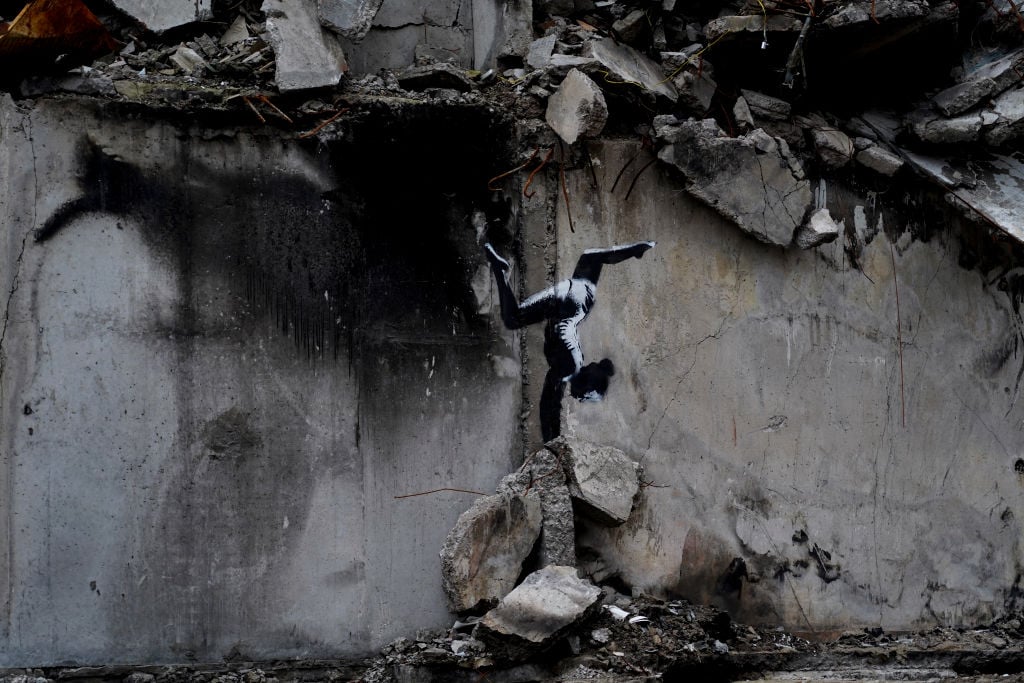
In a stunning reveal, the street artist Banksy took to Instagram on Friday to unveil a new work on the deserted remains of a bombed out building in the town of Borodyanka in Ukraine. The post has since received more than 2 million likes, and the secretive artist has confirmed that he has visited the war-torn region, completing a total of seven pieces there.
The first work done in Borodyanka features a female gymnast in a leotard, possibly a young girl, doing an elegant handstand in the rubble of the towering wreckage.
A new piece of graffiti by Banksy on the wall of destroyed residential building in the town of Borodyanka. Photo: Maxym Marusenko/NurPhoto via Getty Images.
About 48km north of Kyiv, Borodyanka was occupied by Russian forces until it was liberated in April. During this time it was bombed extensively, with airstrikes reportedly targeting civilians. The building the art work was stenciled on appears to have been a former apartment block.
Graffiti by Banksy in the city of Borodyanka, Ukraine. Photo: Maxym Marusenko/NurPhoto via Getty Images.
Another work in Borodyanka features a young boy defeating a grown man at judo, a martial art in which the Russian president Vladmir Putin is known to be a black belt.
One mural in Irpin, also near Kyiv, shows a female gymnast in a neck brace dancing with a ribbon. This city was also particularly hard hit during the early stages of the Russian invasion and has since been designated a Hero City of Ukraine.
Graffiti by Banksy in the town of Irpin, Ukraine. Photo: Maxym Marusenko/NurPhoto via Getty Images.
A piece of graffiti art in Kyiv, stenciled on a stack of concrete blocks that had a metal tank trap placed in front of them, originally showed two children appearing to use the device as a seesaw. The trap, often referred to as a hedgehog, has since been removed, however, leaving one of the kids hovering in the air.
New graffiti work of two children is painted on blocks of concrete in Independence Square in Kyiv. Originally, a metal tank trap, used to sit between the children giving the appearance that they were playing on a seesaw. Photo: Ed Ram/Getty Images.
Another confirmed artwork by the artist makes use of an existing graffitied penis, which has been transformed to look like a missile on a military truck.
A new piece of graffiti art by Banksy in Kyiv, Ukraine. Photo: courtesy of Banksy.
Banksy’s artworks tend to contain messages that are socially or politically motivated, and they have been popping up for decades now on city streets all over the world. In his works in Ukraine, the artist hints at how gravely the lives of normal citizens have been affected by the war through his trademark use of jarring juxtapositions.
In another work painted on the yellow wall of a destroyed and disused building in Hostomel, near Antonov Airport, a female figure stands in a dressing gown and her hair in curlers, wearing a gas mask and wielding a fire extinguisher. The area had been badly bombed when it was temporarily captured by Russian forces.
A new piece of graffiti art by Banksy in Hostomel, Ukraine. Photo: courtesy of Banksy.
A mural in the village of Gorenka shows a man washing himself in a bathtub in the spot where someone’s living quarters have been destroyed by war, a stark reminder of how many lives have been uprooted in Ukraine.
A new piece of graffiti by Banksy in a destroyed residential building in the village of Gorenka. Photo: Maxym Marusenko/NurPhoto via Getty Images.
Originally from Bristol, the pseudonymous Banksy started out making street art in U.K. cities before branching out internationally. He has not previously shied from working in conflict zones, including Gaza and the West Bank. These are his first public works in over a year.
Banksy is not the first street artist to respond to the war against Ukraine. In March, the French artist JR visited the city of Lviv and worked with over 100 locals to help unfurl and hold a huge 148-foot-tall image of a five-year-old refugee girl named Valeriia.
The large scale public artwork was photographed using an overhead drone and the installation shot was used as the cover of TIME magazine.
The image, printed on tarp, was based on a photograph by Ukrainian photographer Artem Lurchenko, who spotted the child as she was fleeing the country with her mother.
“This little girl is the future and, in this war, she reminds us what Ukrainians are fighting for,” JR wrote on Instagram.